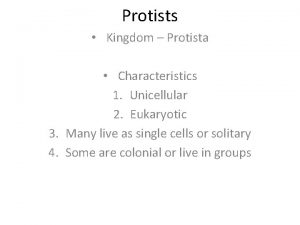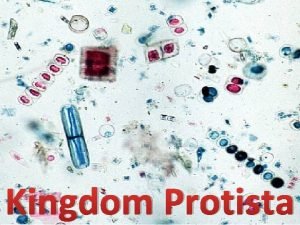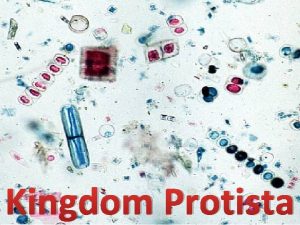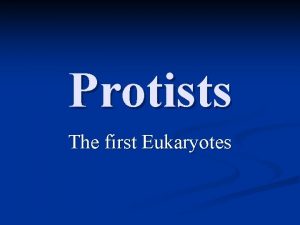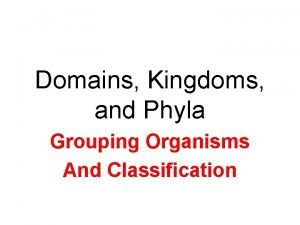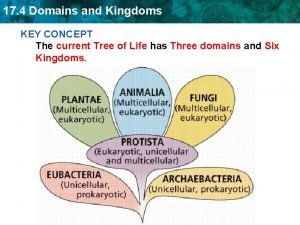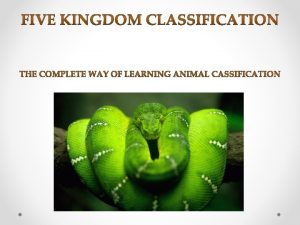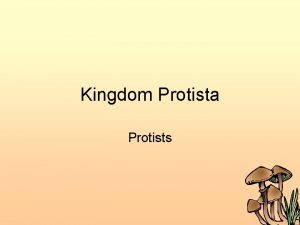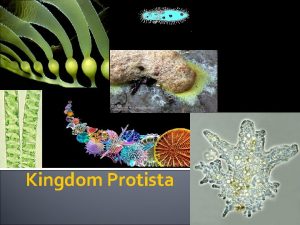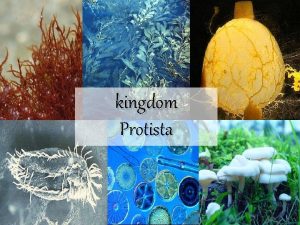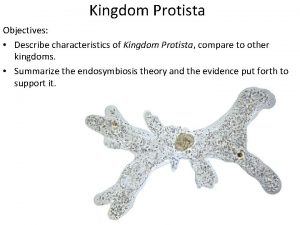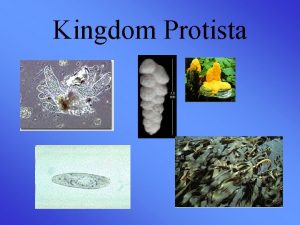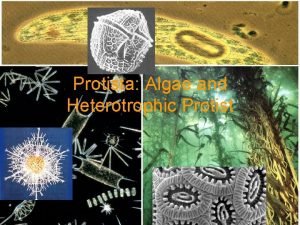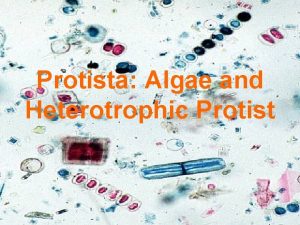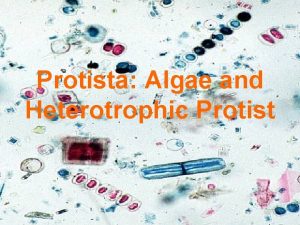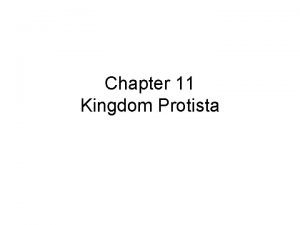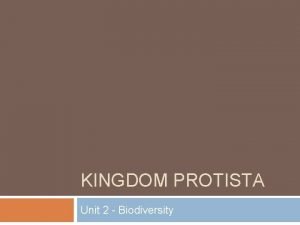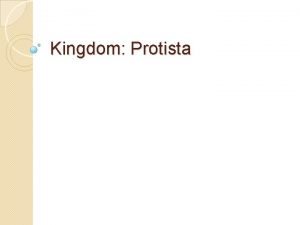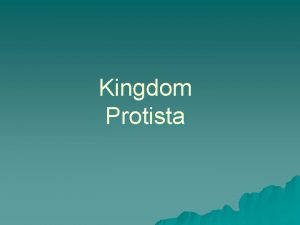KINGDOM PROTISTA PROTIST CHARACTERISTICS Organisms in the kingdom

















- Slides: 17

KINGDOM PROTISTA

PROTIST CHARACTERISTICS Organisms in the kingdom Protista first appeared about 1. 5 billion years ago. Protists are eukaryotic organisms These organisms are mostly single-celled

CELL TYPES: PROKARYOTES & EUKARYOTES Prokaryotes Archaea, bacteria All single-celled No membrane-bound organelles Genetic material not contained in membrane Eukaryotes Protista, Fungi, Plantae, Animalia Single-celled or multicellular Membrane-bound organelles (ex. Mitochondria) Genetic material contained in a membrane - nucleus

GENERAL CHARACTERISTICS Kingdom Protista contains 115, 000 species extremely diverse in their cell structures, patterns of nutrition, metabolic needs, reproduction, and habitats. grab-bag of organisms that do not fit into the other kingdoms.

CLASSIFICATION difficult to classify so for the purposes of this class we will group them by their nutritional patterns. Animal-like protists (aka protozoa) Ingest – eat food Ex. Zoomastigina, Sarcodina (Amoeba), Ciliophora, Sporozoa Fungi-like protists Absorbtive Ex. Slime molds Plant-like protists Photosynthetic Ex. Chrysophyta, Euglenophyta, Pyrrophyta

ANIMAL-LIKE PROTISTS

ZOOMASTIGINA protists possess one or more flagella used for locomotion. Some zoomastigina are heterotrophic and feed on other protists. Other species live as internal parasites on animals, including humans and may be pathogenic. Ex. Sleeping sickness (a serious African disease) is caused Trypanosoma gambiensis. It’s carrier is the tsetse fly.

Giardia, a zooflagellate, can cause digestive problems in humans. This illness known as “beaver fever” is caused by drinking polluted lake water. Trichonympha, is a wood digesting zooflagellate which lives by the thousands in the guts of termites. Trypanosoma gambiensis Giardia Trichonympha

AMEBAE Single-celled protozoans with no set body shape. Create temporary projections of cytoplasm called pseudopods to move and feed. Feed on small organisms by endocytosis, engulfing organisms with their pseudopods.

Some amoebas are parasitic. Ex. amoebic dysentery is caused by a species of Entamoeba enter the digestive system after a person drinks infected water.

CILIOPHORA Ciliophora covered with hair-like projections (cilia) which move back and forth like oars to move the organism. Ex. paramecium

SPOROZOA Sporozoans are protists that produce spores during their asexual phase of reproduction. They are nonmotile and parasitic, obtaining their nutrients from the bodies of their hosts. Example : Plasmodium cause Malaria.

PLANT AND FUNGI-LIKE PROTISTS

MORE PROTISTS Fungus-like Protists All are heterotrophic and most are decomposers that feed on dead plants and animals tend to live in cool, damp places. Acellular slime moulds, cellular slime moulds Plant-like Protists 24, 000 species of protists that contain chlorophyll and carry out photosynthesis.

EUGLENOPHYTA Euglenophyta are unicellular flagellates Euglena is a freshwater organism that moves using a flagellum. In the day, it is fully autotrophic and it photosynthesizes. In the dark, it become heterotrophic and feeds on dead organic material in the water.

CHRYSOPHYTA Diatoms- are a golden colouration due to yellow-brown pigments contained within their glasslike shells made of silica. Tremendously abundant in the oceans and are the key food source in marine and freshwater ecosystems.

PYRROPHYTA Extremely abundant in both marine and freshwater environments. They are luminescent when the surrounding water is agitated. Produces a “red-tide” and also produces toxins. As shellfish and fish feed on them the toxins concentrate in their bodies and can move through the food chain.
 Kingdom protista characteristics
Kingdom protista characteristics Diatoms unicellular or multicellular
Diatoms unicellular or multicellular Characteristics of protista
Characteristics of protista Character of protista
Character of protista Kingdom protista characteristics
Kingdom protista characteristics Dunia plantae
Dunia plantae Domain: eukarya kingdom: protista
Domain: eukarya kingdom: protista Old kingdom middle kingdom new kingdom
Old kingdom middle kingdom new kingdom Nnn ruled
Nnn ruled Roman empire
Roman empire Old kingdom middle kingdom new kingdom
Old kingdom middle kingdom new kingdom Why do organisms interact with other organisms
Why do organisms interact with other organisms Multicellular unicellular
Multicellular unicellular A unicellular protist is part of which domain?
A unicellular protist is part of which domain? Respirasi protista
Respirasi protista Examples of archaea kingdom
Examples of archaea kingdom 4 kingdoms of life
4 kingdoms of life Five kingdom classification
Five kingdom classification
